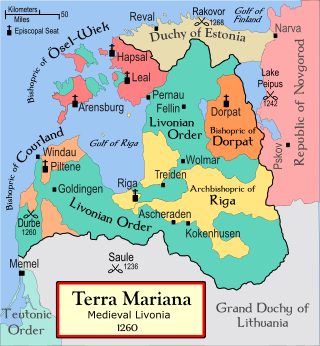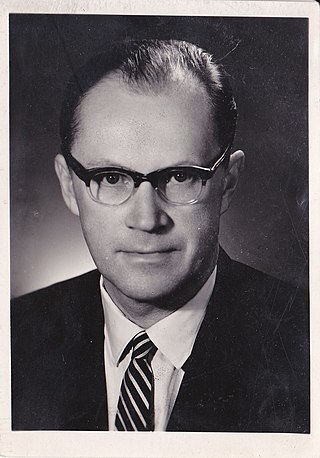Related Research Articles

Saint George's Night Uprising in 1343–1345 was an unsuccessful attempt by the indigenous Estonian population in the Duchy of Estonia, the Bishopric of Ösel-Wiek, and the insular territories of the State of the Teutonic Order to rid themselves of Danish and German rulers and landlords who had conquered the country in the 13th century during the Livonian Crusade; and to eradicate the non-indigenous Christian religion. After initial success the revolt was ended by the invasion of the Teutonic Order. In 1346, the Duchy of Estonia was sold for 19,000 Köln marks by the King of Denmark to the Teutonic Order. The shift of sovereignty from Denmark to the State of the Teutonic Order took place on November 1, 1346.
Dmitri Bruns was a Latvia-born Soviet and Estonian architect and architecture theorist of Russian origin.
Eduard Wiiralt was a well-known Estonian graphic artist. In art history, Wiiralt is considered as the most remarkable master of Estonian graphic art in the first half of his century. The best-known of his works include "Inferno", "Hell", "Cabaret", "Heads of Negroes", "Sleeping Tiger", and "Head of a Camel".

The Holocaust in Estonia refers to Nazi crimes during the occupation of Estonia by Nazi Germany.
Paul Ariste was an Estonian linguist renowned for his studies of the Finno-Ugric languages, Yiddish and Baltic Romani language.

Jaan Eilart was an Estonian phytogeographer, landscape ecologist, cultural historian and conservationist.
Liivia-Maria Laasimer was an Estonian botanist, geobotanist, bryologist and plant systematist.

Gunnar Kangro was an Estonian mathematician. He worked mainly on summation theory. He taught various courses on mathematical analysis, functional analysis and algebra in University of Tartu and he has written several university textbooks.
Iko Maran was an Estonian playwright and children's book author.
The Institute of Party History of the Central Committee of the Communist Party of Estonia was a research body in the Estonian SSR, managed under the Central Committee of the Communist Party of Estonia. Founded in 1947, the institute functioned as the republic-level branch of the Marx–Engels–Lenin Institute of the All-Union Communist Party (Bolsheviks). The institute was based in Tallinn.

Ellen Niit was an Estonian children's writer, poet and translator. Over her lifetime, she penned more than forty books of both prose and poetry for children. She also wrote a number of collections of prose and poetry for adults. Her works have been translated into eighteen languages.
Valgus is an Estonian publisher. Valgus publishes, for example, dictionaries, study books, manuals, popular science books. Valgus' headquarters are located in Tallinn.
Ilmar Sikemäe was an Estonian writer.
Endel Nirk was an Estonian literary scientist, critic and writer.
Karl Treufeldt was an Estonian revolutionary and proletarian publicist. He was a revolutionary organizer during the Commune of the Working People of Estonia 1918-1919, leading the Red Guards in Haapsalu. After the defeat of the Commune, he was active in Estonian-language publishing activities in Soviet Russia.
Gennady L’vovich Muravin was a Russian translator, journalist and artist, who lived and worked mostly in Estonia and Finland.

Maatamees was an Estonian-language newspaper published from Reval (Tallinn), Autonomous Governorate of Estonia, Russia between 14 July [O.S. 1 July] 1917 and 22 February 1918. The newspaper was an organ of the Rural Sections of the North Baltic Committee of the Russian Social Democratic Labour Party (Bolsheviks). Maatamees had a circulation of about 4,000 copies. All in all, 84 issues of Maatamees were published.
Hermine Kallista Kann was an Estonian linguist and teacher.
Alo Hoidre was an Estonian painter, book illustrator, and printmaker.
Rudolf Sirge was an Estonian writer.
References
- 1 2 "Eesti Riiklik Kirjastus". entsyklopeedia.ee. Eesti Entsüklopeedia. Retrieved 1 December 2020.